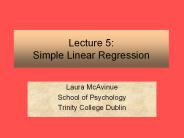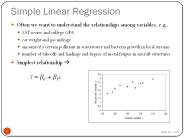Equations in Simple Regression Analysis - PowerPoint PPT Presentation
1 / 26
Title:
Equations in Simple Regression Analysis
Description:
Point-biserial and Phi correlation. These are both Pearson Product-moment correlations. The Point-biserial correlation is used when on variable is a scale variable and ... – PowerPoint PPT presentation
Number of Views:99
Avg rating:3.0/5.0
Title: Equations in Simple Regression Analysis
1
Equations in Simple Regression Analysis
2
The Variance
3
The standard deviation
4
The covariance
5
The Pearson product moment correlation
6
The normal equations (for the regressions of y
on x)
7
The structural model (for an observation on
individual i)
8
The regression equation
9
Partitioning a deviation score, y
10
Partitioning the sum of squared deviations (sum
of squares, SSy)
11
Calculation of proportions of sums of squares due
to regression and due to error (or residual)
12
Alternative formulas for computing the sums of
squares due to regression
13
Test of the regression coefficient, byx, (i.e.
test the null hypothesis that byx 0)
- First compute the variance of estimate
14
Test of the regression coefficient, byx, (i.e.
test the null hypothesis that byx 0)
- Then obtain the standard error of estimate
- Then compute the standard error of the regression
coefficient, Sb
15
The test of significance of the regression
coefficient (byx)
- The significance of the regression coefficient is
tested using a t test with (N-k-1) degrees of
freedom
16
Computing regression using correlations
- The correlation, in the population, is given by
- The population correlation coefficient, ?xy, is
estimated by the sample correlation coefficient,
rxy
17
Sums of squares, regression (SSreg)
- Recalling that r2 gives the proportion of
variance of Y accounted for (or explained) by X,
we can obtain - or, in other words, SSreg is that portion of SSy
predicted or explained by the regression of Y on
X.
18
Standard error of estimate
- From SSres we can compute the variance of
estimate and standard error of estimate as - (Note alternative formulas were given earlier.)
19
Testing the Significance of r
- The significance of a correlation coefficient, r,
is tested using a t test - With N-2 degrees of freedom.
20
Testing the difference between two correlations
- To test the difference between two Pearson
correlation coefficients, use the Comparing two
correlation coefficients calculator on my web
site.
21
Testing the difference between two regression
coefficients
- This, also, is a t test
- Where
- was given earlier. When the variances, , are
unequal, used the pooled estimate given on page
258 of our textbook.
22
Other measures of correlation
- Chapter 10 in the text gives several alternative
measures of correlation - Point-biserial correlation
- Phi correlation
- Biserial correlation
- Tetrachoric correlation
- Spearman correlation
23
Point-biserial and Phi correlation
- These are both Pearson Product-moment
correlations - The Point-biserial correlation is used when on
variable is a scale variable and the other
represents a true dichotomy. - For instance, the correlation between an
performance on an itemthe dichotomous
variableand the total score on a testthe scaled
variable.
24
Point-biserial and Phi correlation
- The Phi correlation is used when both variables
represent a true dichotomy. - For instance, the correlation between two test
items.
25
Biserial and Tetrachoric correlation
- These are non-Pearson correlations.
- Both are rarely used anymore.
- The biserial correlation is used when one
variable is truly a scaled variable and the other
represents an artificial dichotomy. - The Tetrachoric correlation is used when both
variables represent an artificial dichotomy.
26
Spearmans Rho Coefficient and Kendalls Tau
Coefficient
- Spearmans rho is used to compute the correlation
between two ordinal (or ranked) variables. - It is the correlation between two sets of ranks.
- Kendalls tau (see pages 286-288 in the text) is
also a measure of the relationship between two
sets of ranked data.































